The Rwandan Refugee Crisis 1994: Causes, International Operations, and Supply Chain Management
VerifiedAdded on 2022/11/18
|12
|3457
|125
AI Summary
This report analyzes the Rwandan refugee crisis of 1994, its causes, international operations, and supply chain management. It highlights the major issues faced during the crisis, including tribalism, insecurity, and poor infrastructure. The report also proposes recommendations to prevent future crises from occurring.
Contribute Materials
Your contribution can guide someone’s learning journey. Share your
documents today.
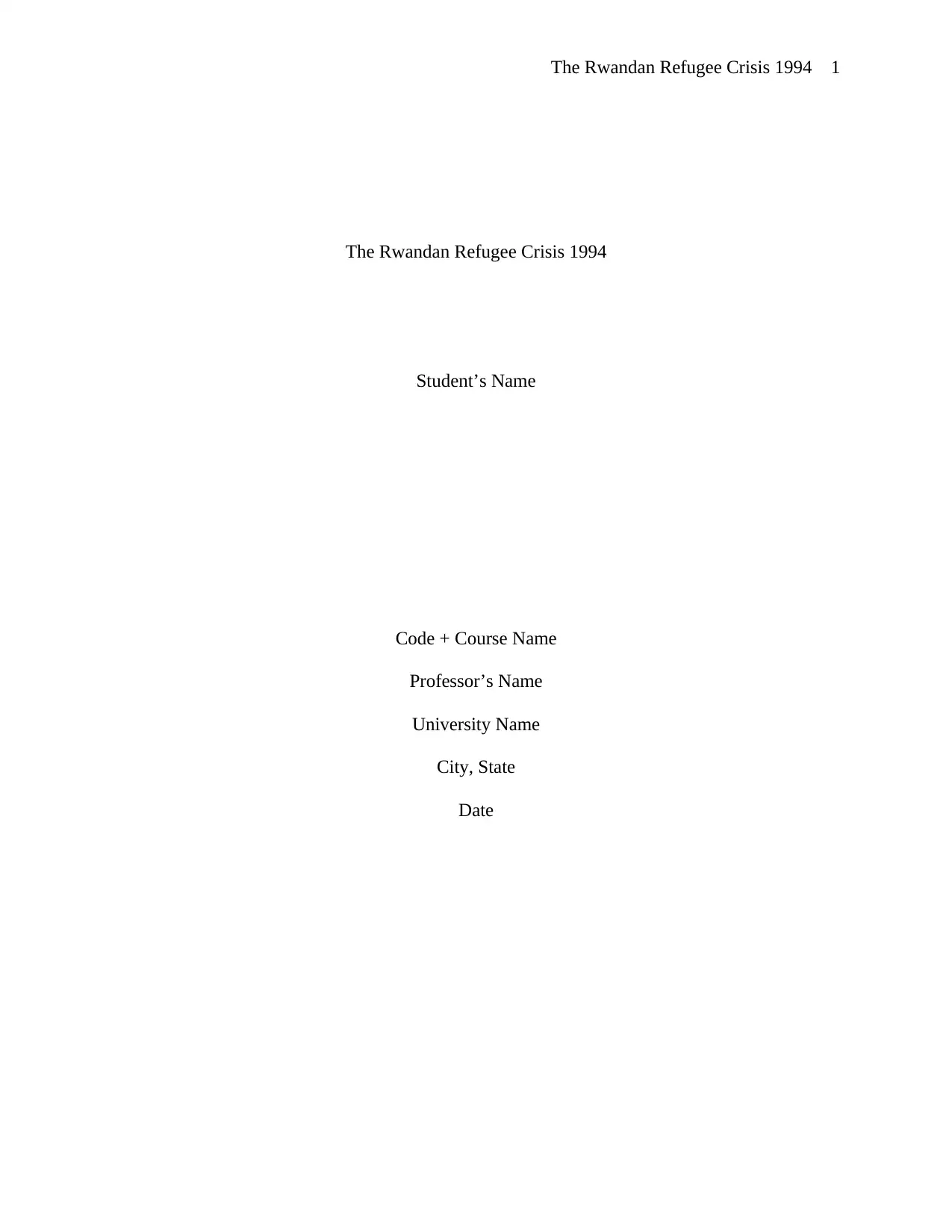
The Rwandan Refugee Crisis 1994 1
The Rwandan Refugee Crisis 1994
Student’s Name
Code + Course Name
Professor’s Name
University Name
City, State
Date
The Rwandan Refugee Crisis 1994
Student’s Name
Code + Course Name
Professor’s Name
University Name
City, State
Date
Secure Best Marks with AI Grader
Need help grading? Try our AI Grader for instant feedback on your assignments.
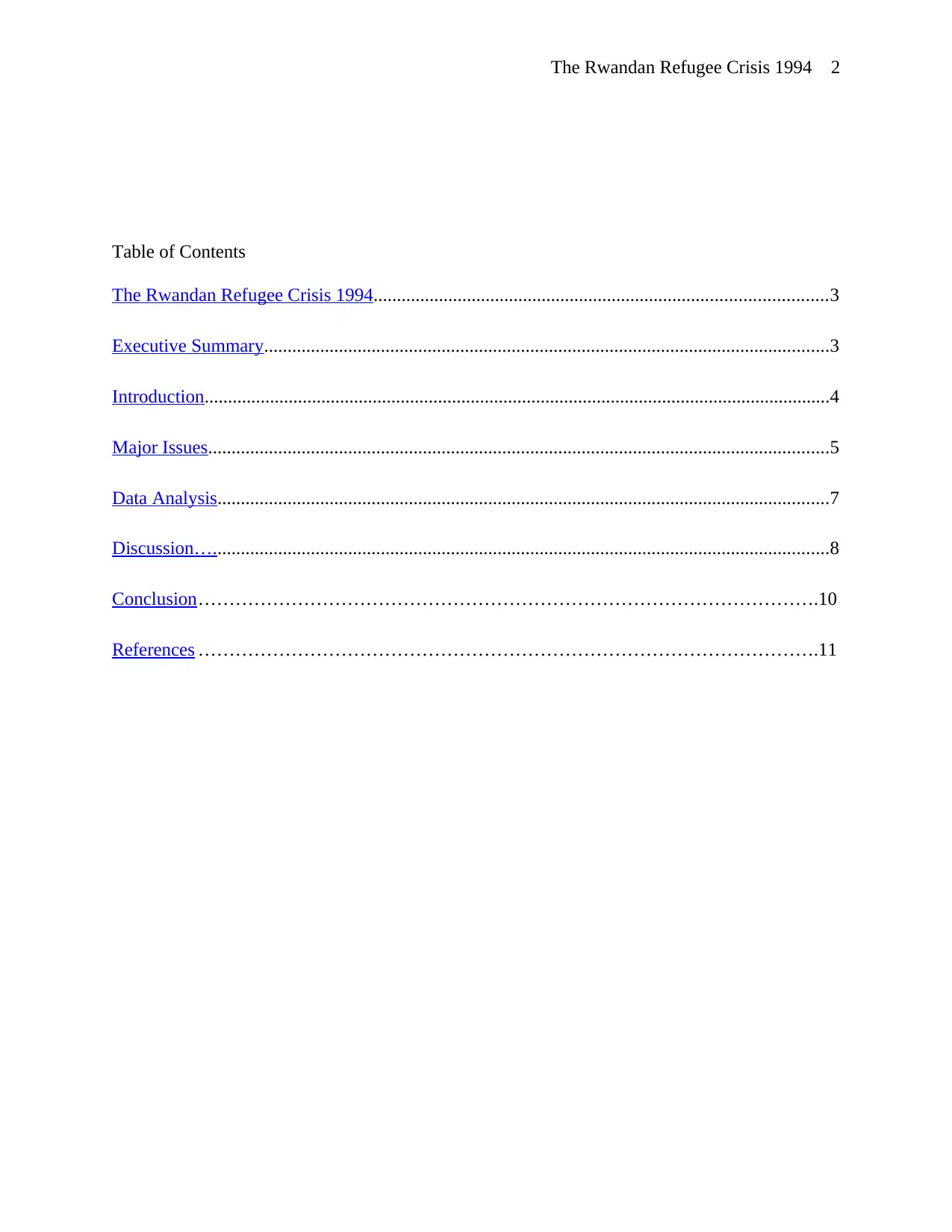
The Rwandan Refugee Crisis 1994 2
Table of Contents
The Rwandan Refugee Crisis 1994.................................................................................................3
Executive Summary.........................................................................................................................3
Introduction......................................................................................................................................4
Major Issues.....................................................................................................................................5
Data Analysis...................................................................................................................................7
Discussion…....................................................................................................................................8
Conclusion……………………………………………………………………………………….10
References ……………………………………………………………………………………….11
Table of Contents
The Rwandan Refugee Crisis 1994.................................................................................................3
Executive Summary.........................................................................................................................3
Introduction......................................................................................................................................4
Major Issues.....................................................................................................................................5
Data Analysis...................................................................................................................................7
Discussion…....................................................................................................................................8
Conclusion……………………………………………………………………………………….10
References ……………………………………………………………………………………….11
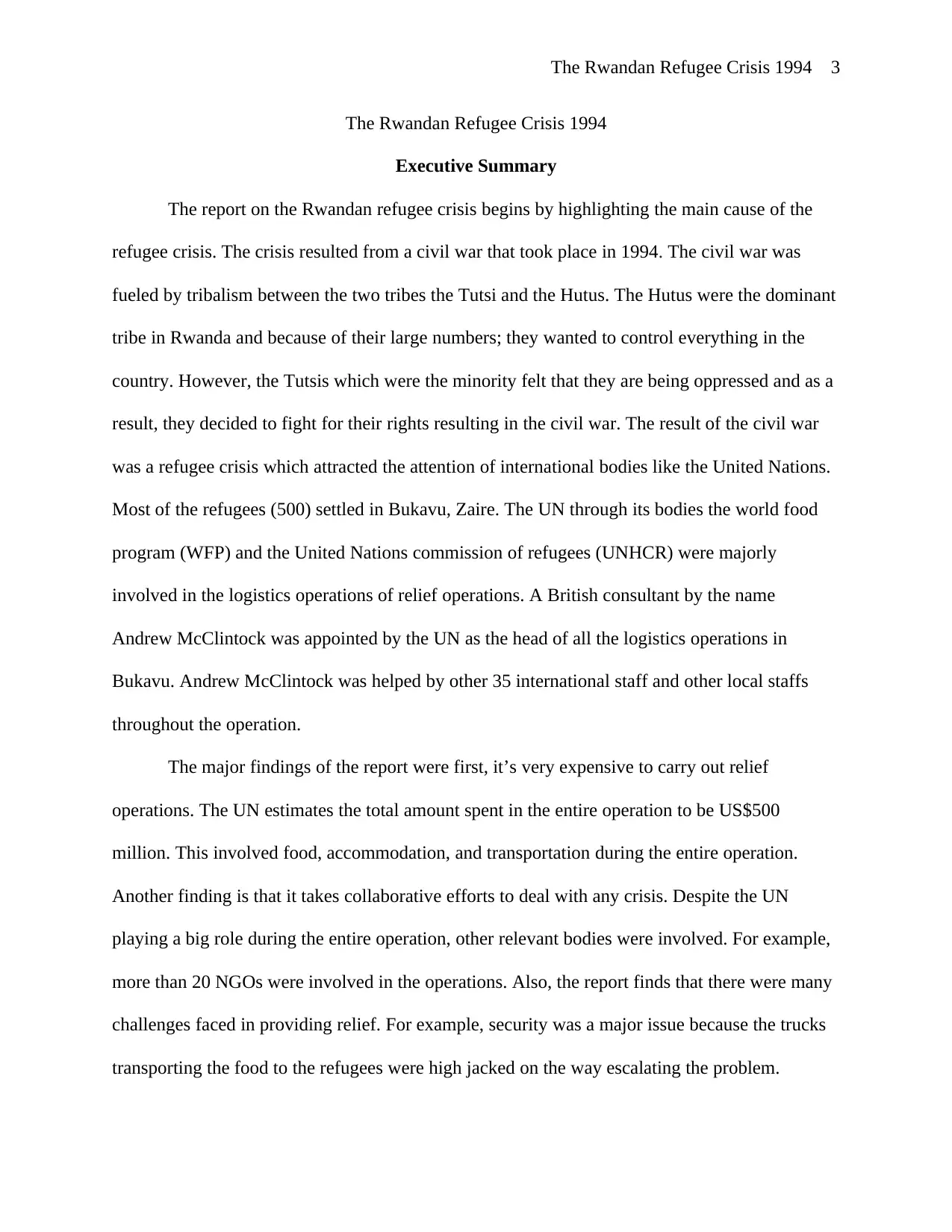
The Rwandan Refugee Crisis 1994 3
The Rwandan Refugee Crisis 1994
Executive Summary
The report on the Rwandan refugee crisis begins by highlighting the main cause of the
refugee crisis. The crisis resulted from a civil war that took place in 1994. The civil war was
fueled by tribalism between the two tribes the Tutsi and the Hutus. The Hutus were the dominant
tribe in Rwanda and because of their large numbers; they wanted to control everything in the
country. However, the Tutsis which were the minority felt that they are being oppressed and as a
result, they decided to fight for their rights resulting in the civil war. The result of the civil war
was a refugee crisis which attracted the attention of international bodies like the United Nations.
Most of the refugees (500) settled in Bukavu, Zaire. The UN through its bodies the world food
program (WFP) and the United Nations commission of refugees (UNHCR) were majorly
involved in the logistics operations of relief operations. A British consultant by the name
Andrew McClintock was appointed by the UN as the head of all the logistics operations in
Bukavu. Andrew McClintock was helped by other 35 international staff and other local staffs
throughout the operation.
The major findings of the report were first, it’s very expensive to carry out relief
operations. The UN estimates the total amount spent in the entire operation to be US$500
million. This involved food, accommodation, and transportation during the entire operation.
Another finding is that it takes collaborative efforts to deal with any crisis. Despite the UN
playing a big role during the entire operation, other relevant bodies were involved. For example,
more than 20 NGOs were involved in the operations. Also, the report finds that there were many
challenges faced in providing relief. For example, security was a major issue because the trucks
transporting the food to the refugees were high jacked on the way escalating the problem.
The Rwandan Refugee Crisis 1994
Executive Summary
The report on the Rwandan refugee crisis begins by highlighting the main cause of the
refugee crisis. The crisis resulted from a civil war that took place in 1994. The civil war was
fueled by tribalism between the two tribes the Tutsi and the Hutus. The Hutus were the dominant
tribe in Rwanda and because of their large numbers; they wanted to control everything in the
country. However, the Tutsis which were the minority felt that they are being oppressed and as a
result, they decided to fight for their rights resulting in the civil war. The result of the civil war
was a refugee crisis which attracted the attention of international bodies like the United Nations.
Most of the refugees (500) settled in Bukavu, Zaire. The UN through its bodies the world food
program (WFP) and the United Nations commission of refugees (UNHCR) were majorly
involved in the logistics operations of relief operations. A British consultant by the name
Andrew McClintock was appointed by the UN as the head of all the logistics operations in
Bukavu. Andrew McClintock was helped by other 35 international staff and other local staffs
throughout the operation.
The major findings of the report were first, it’s very expensive to carry out relief
operations. The UN estimates the total amount spent in the entire operation to be US$500
million. This involved food, accommodation, and transportation during the entire operation.
Another finding is that it takes collaborative efforts to deal with any crisis. Despite the UN
playing a big role during the entire operation, other relevant bodies were involved. For example,
more than 20 NGOs were involved in the operations. Also, the report finds that there were many
challenges faced in providing relief. For example, security was a major issue because the trucks
transporting the food to the refugees were high jacked on the way escalating the problem.

The Rwandan Refugee Crisis 1994 4
Introduction
Disasters and crises have been part of human life for a very long time. Some of these
crises are natural while some are engineered by human activities (Beswick 2014, p.212).
Similarly, some of the crises are of international concern while some are of national concern.
Whenever humanity has been faced with a particular crisis, there have been collaborative efforts
put in place both locally and internationally to deal with the situation. In the Rwandan refugee
crisis, the efforts of international bodies and NGOs were majorly involved. The united nations in
collaboration with more than 20 NGOs were involved in all the logistics operations during the
entire operations. However, because most of the UN and other international staff used majorly
English, the support of the local staff was needed in translating to the locals what was required of
them (Baines 2017, p.87). In addition, the regional support of countries like Kenya, Uganda, and
Tanzania which are neighboring countries was sought by the UN whenever it was necessary. For
example, kitchen sets were sourced from Kenya and Egypt while blankets were sourced from
Zimbabwe (Bariagaber 2019, p.100). This shows how countries can collaborate to deal with a
crisis like this.
Generally, the report focuses on steps that were involved in relief operations during the
refugee crisis that was experienced in Rwanda in 1994, by first explaining what resulted in the
crisis. The report outlines all the bodies and institutions that were involved in the operation, for
example, the United Nations, the world health organization, several NGOs and the individual
countries that provided their support like Zaire, Kenya, and Egypt. Finally, the report lists all the
challenges that were involved during the entire process of providing relief to the refugees. For
example, the issue of security, language barrier and harsh weather.
Introduction
Disasters and crises have been part of human life for a very long time. Some of these
crises are natural while some are engineered by human activities (Beswick 2014, p.212).
Similarly, some of the crises are of international concern while some are of national concern.
Whenever humanity has been faced with a particular crisis, there have been collaborative efforts
put in place both locally and internationally to deal with the situation. In the Rwandan refugee
crisis, the efforts of international bodies and NGOs were majorly involved. The united nations in
collaboration with more than 20 NGOs were involved in all the logistics operations during the
entire operations. However, because most of the UN and other international staff used majorly
English, the support of the local staff was needed in translating to the locals what was required of
them (Baines 2017, p.87). In addition, the regional support of countries like Kenya, Uganda, and
Tanzania which are neighboring countries was sought by the UN whenever it was necessary. For
example, kitchen sets were sourced from Kenya and Egypt while blankets were sourced from
Zimbabwe (Bariagaber 2019, p.100). This shows how countries can collaborate to deal with a
crisis like this.
Generally, the report focuses on steps that were involved in relief operations during the
refugee crisis that was experienced in Rwanda in 1994, by first explaining what resulted in the
crisis. The report outlines all the bodies and institutions that were involved in the operation, for
example, the United Nations, the world health organization, several NGOs and the individual
countries that provided their support like Zaire, Kenya, and Egypt. Finally, the report lists all the
challenges that were involved during the entire process of providing relief to the refugees. For
example, the issue of security, language barrier and harsh weather.
Secure Best Marks with AI Grader
Need help grading? Try our AI Grader for instant feedback on your assignments.
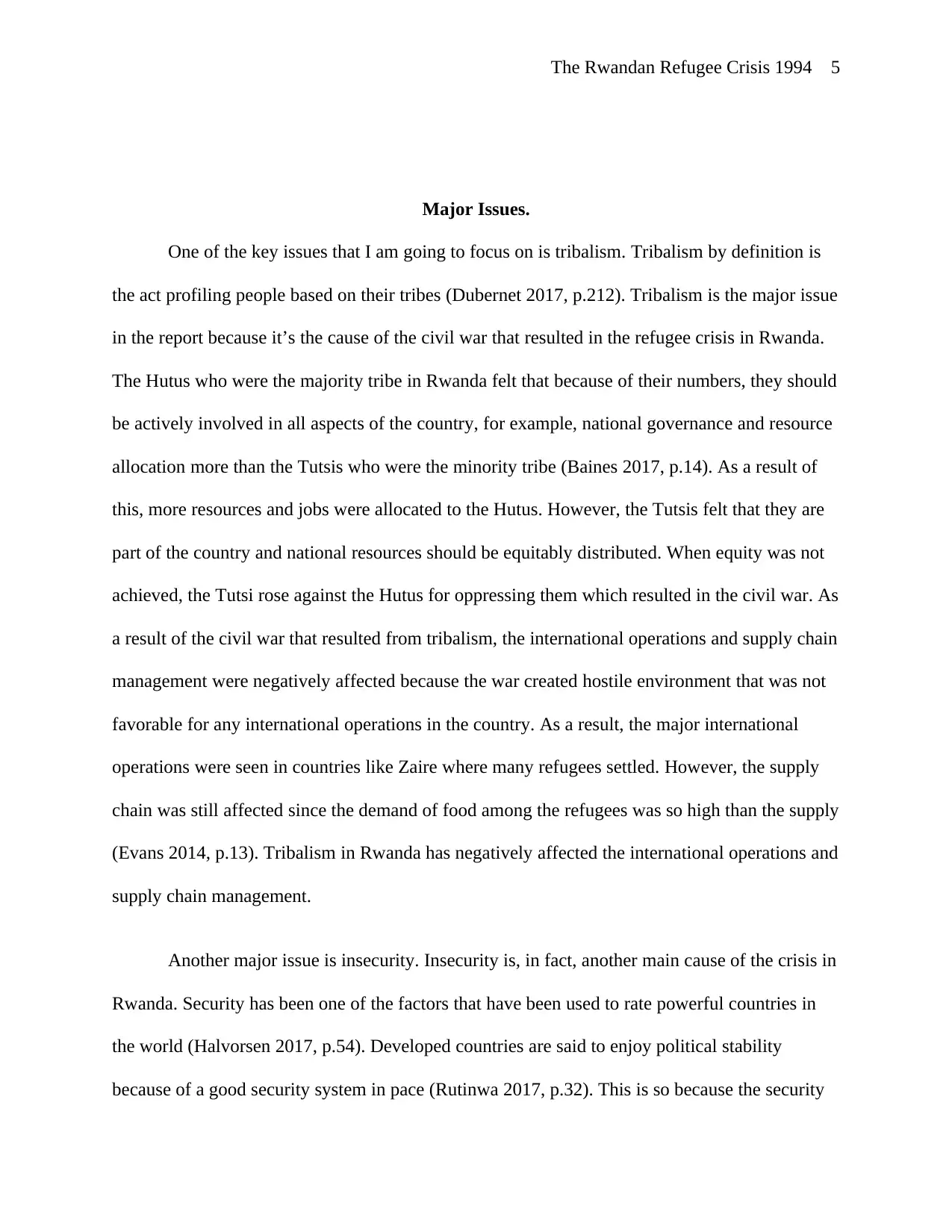
The Rwandan Refugee Crisis 1994 5
Major Issues.
One of the key issues that I am going to focus on is tribalism. Tribalism by definition is
the act profiling people based on their tribes (Dubernet 2017, p.212). Tribalism is the major issue
in the report because it’s the cause of the civil war that resulted in the refugee crisis in Rwanda.
The Hutus who were the majority tribe in Rwanda felt that because of their numbers, they should
be actively involved in all aspects of the country, for example, national governance and resource
allocation more than the Tutsis who were the minority tribe (Baines 2017, p.14). As a result of
this, more resources and jobs were allocated to the Hutus. However, the Tutsis felt that they are
part of the country and national resources should be equitably distributed. When equity was not
achieved, the Tutsi rose against the Hutus for oppressing them which resulted in the civil war. As
a result of the civil war that resulted from tribalism, the international operations and supply chain
management were negatively affected because the war created hostile environment that was not
favorable for any international operations in the country. As a result, the major international
operations were seen in countries like Zaire where many refugees settled. However, the supply
chain was still affected since the demand of food among the refugees was so high than the supply
(Evans 2014, p.13). Tribalism in Rwanda has negatively affected the international operations and
supply chain management.
Another major issue is insecurity. Insecurity is, in fact, another main cause of the crisis in
Rwanda. Security has been one of the factors that have been used to rate powerful countries in
the world (Halvorsen 2017, p.54). Developed countries are said to enjoy political stability
because of a good security system in pace (Rutinwa 2017, p.32). This is so because the security
Major Issues.
One of the key issues that I am going to focus on is tribalism. Tribalism by definition is
the act profiling people based on their tribes (Dubernet 2017, p.212). Tribalism is the major issue
in the report because it’s the cause of the civil war that resulted in the refugee crisis in Rwanda.
The Hutus who were the majority tribe in Rwanda felt that because of their numbers, they should
be actively involved in all aspects of the country, for example, national governance and resource
allocation more than the Tutsis who were the minority tribe (Baines 2017, p.14). As a result of
this, more resources and jobs were allocated to the Hutus. However, the Tutsis felt that they are
part of the country and national resources should be equitably distributed. When equity was not
achieved, the Tutsi rose against the Hutus for oppressing them which resulted in the civil war. As
a result of the civil war that resulted from tribalism, the international operations and supply chain
management were negatively affected because the war created hostile environment that was not
favorable for any international operations in the country. As a result, the major international
operations were seen in countries like Zaire where many refugees settled. However, the supply
chain was still affected since the demand of food among the refugees was so high than the supply
(Evans 2014, p.13). Tribalism in Rwanda has negatively affected the international operations and
supply chain management.
Another major issue is insecurity. Insecurity is, in fact, another main cause of the crisis in
Rwanda. Security has been one of the factors that have been used to rate powerful countries in
the world (Halvorsen 2017, p.54). Developed countries are said to enjoy political stability
because of a good security system in pace (Rutinwa 2017, p.32). This is so because the security

The Rwandan Refugee Crisis 1994 6
intelligence in such countries is very ineffective such that any illegal activities like the
preparation of civil war are unmasked in advance and necessary measures are put in place to stop
them. In countries where insecurity is the order of the day, they are considered failed state since
no important developments can take place in an insecure environment. Insecurity negatively
affected the international operations and supply chain management through the refugee crisis in
Rwanda. During the crisis, the international bodies like the UN and WHO supplied food and
other resources to the refugees in Zaire. However, due to insecurity in the area, the international
operations of supplying the refugees with food were negatively affected when the trucks
supplying food to the refugees were high jacked on way and food taken. This resulted to supply
chain issues because the demand of food continued to be high while the supply reduced due to
security issues. Since there was no any governing authority within the region, reports of
insecurity by the international staffs working in the area did no solve the issue.
The third issue is poor infrastructure. Infrastructure refers to facilities and structures
within a particular area (Waters 2018, p.340). These facilities and structures can positively or
negatively affect the international operations and supply chain management (Yamashita 2017, p.
27). Throughout the relief operation in Rwanda, infrastructure has negatively affected the
international operations and supply chain management. For example, as a result of poorly done
roads, the trucks transporting foods to the refugee camps took longer time than expected. This
negatively affected the international operations by the United Nations and the world health
organization. This is so because food arrived late than expected finding some people already
succumbed to hunger. Also, as a result of the crisis that was in place, many refugee houses were
done in hurry with poor planning and locations. When the rains came, such houses were swept
away leaving the people in the cold. This negatively affected the international operations by the
intelligence in such countries is very ineffective such that any illegal activities like the
preparation of civil war are unmasked in advance and necessary measures are put in place to stop
them. In countries where insecurity is the order of the day, they are considered failed state since
no important developments can take place in an insecure environment. Insecurity negatively
affected the international operations and supply chain management through the refugee crisis in
Rwanda. During the crisis, the international bodies like the UN and WHO supplied food and
other resources to the refugees in Zaire. However, due to insecurity in the area, the international
operations of supplying the refugees with food were negatively affected when the trucks
supplying food to the refugees were high jacked on way and food taken. This resulted to supply
chain issues because the demand of food continued to be high while the supply reduced due to
security issues. Since there was no any governing authority within the region, reports of
insecurity by the international staffs working in the area did no solve the issue.
The third issue is poor infrastructure. Infrastructure refers to facilities and structures
within a particular area (Waters 2018, p.340). These facilities and structures can positively or
negatively affect the international operations and supply chain management (Yamashita 2017, p.
27). Throughout the relief operation in Rwanda, infrastructure has negatively affected the
international operations and supply chain management. For example, as a result of poorly done
roads, the trucks transporting foods to the refugee camps took longer time than expected. This
negatively affected the international operations by the United Nations and the world health
organization. This is so because food arrived late than expected finding some people already
succumbed to hunger. Also, as a result of the crisis that was in place, many refugee houses were
done in hurry with poor planning and locations. When the rains came, such houses were swept
away leaving the people in the cold. This negatively affected the international operations by the
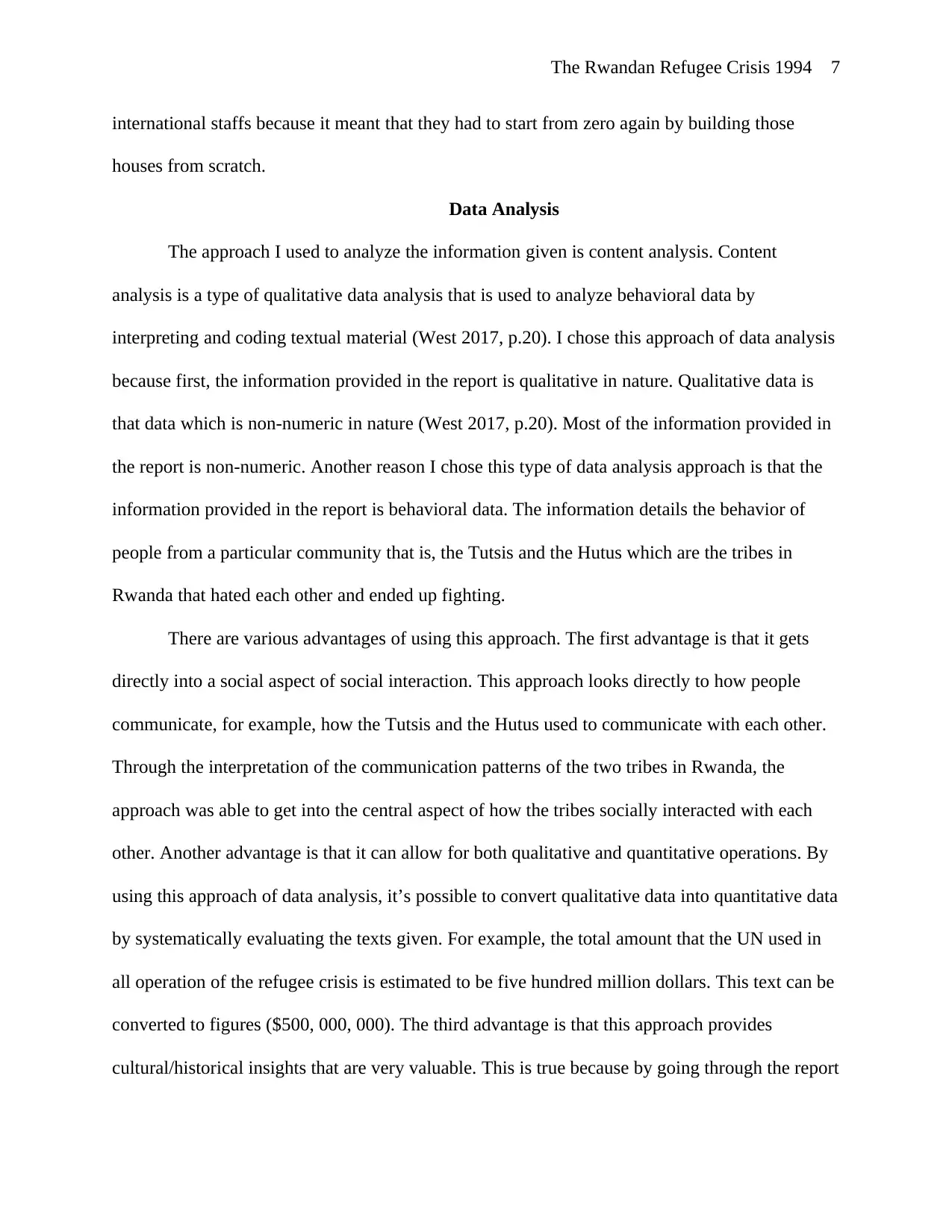
The Rwandan Refugee Crisis 1994 7
international staffs because it meant that they had to start from zero again by building those
houses from scratch.
Data Analysis
The approach I used to analyze the information given is content analysis. Content
analysis is a type of qualitative data analysis that is used to analyze behavioral data by
interpreting and coding textual material (West 2017, p.20). I chose this approach of data analysis
because first, the information provided in the report is qualitative in nature. Qualitative data is
that data which is non-numeric in nature (West 2017, p.20). Most of the information provided in
the report is non-numeric. Another reason I chose this type of data analysis approach is that the
information provided in the report is behavioral data. The information details the behavior of
people from a particular community that is, the Tutsis and the Hutus which are the tribes in
Rwanda that hated each other and ended up fighting.
There are various advantages of using this approach. The first advantage is that it gets
directly into a social aspect of social interaction. This approach looks directly to how people
communicate, for example, how the Tutsis and the Hutus used to communicate with each other.
Through the interpretation of the communication patterns of the two tribes in Rwanda, the
approach was able to get into the central aspect of how the tribes socially interacted with each
other. Another advantage is that it can allow for both qualitative and quantitative operations. By
using this approach of data analysis, it’s possible to convert qualitative data into quantitative data
by systematically evaluating the texts given. For example, the total amount that the UN used in
all operation of the refugee crisis is estimated to be five hundred million dollars. This text can be
converted to figures ($500, 000, 000). The third advantage is that this approach provides
cultural/historical insights that are very valuable. This is true because by going through the report
international staffs because it meant that they had to start from zero again by building those
houses from scratch.
Data Analysis
The approach I used to analyze the information given is content analysis. Content
analysis is a type of qualitative data analysis that is used to analyze behavioral data by
interpreting and coding textual material (West 2017, p.20). I chose this approach of data analysis
because first, the information provided in the report is qualitative in nature. Qualitative data is
that data which is non-numeric in nature (West 2017, p.20). Most of the information provided in
the report is non-numeric. Another reason I chose this type of data analysis approach is that the
information provided in the report is behavioral data. The information details the behavior of
people from a particular community that is, the Tutsis and the Hutus which are the tribes in
Rwanda that hated each other and ended up fighting.
There are various advantages of using this approach. The first advantage is that it gets
directly into a social aspect of social interaction. This approach looks directly to how people
communicate, for example, how the Tutsis and the Hutus used to communicate with each other.
Through the interpretation of the communication patterns of the two tribes in Rwanda, the
approach was able to get into the central aspect of how the tribes socially interacted with each
other. Another advantage is that it can allow for both qualitative and quantitative operations. By
using this approach of data analysis, it’s possible to convert qualitative data into quantitative data
by systematically evaluating the texts given. For example, the total amount that the UN used in
all operation of the refugee crisis is estimated to be five hundred million dollars. This text can be
converted to figures ($500, 000, 000). The third advantage is that this approach provides
cultural/historical insights that are very valuable. This is true because by going through the report
Paraphrase This Document
Need a fresh take? Get an instant paraphrase of this document with our AI Paraphraser
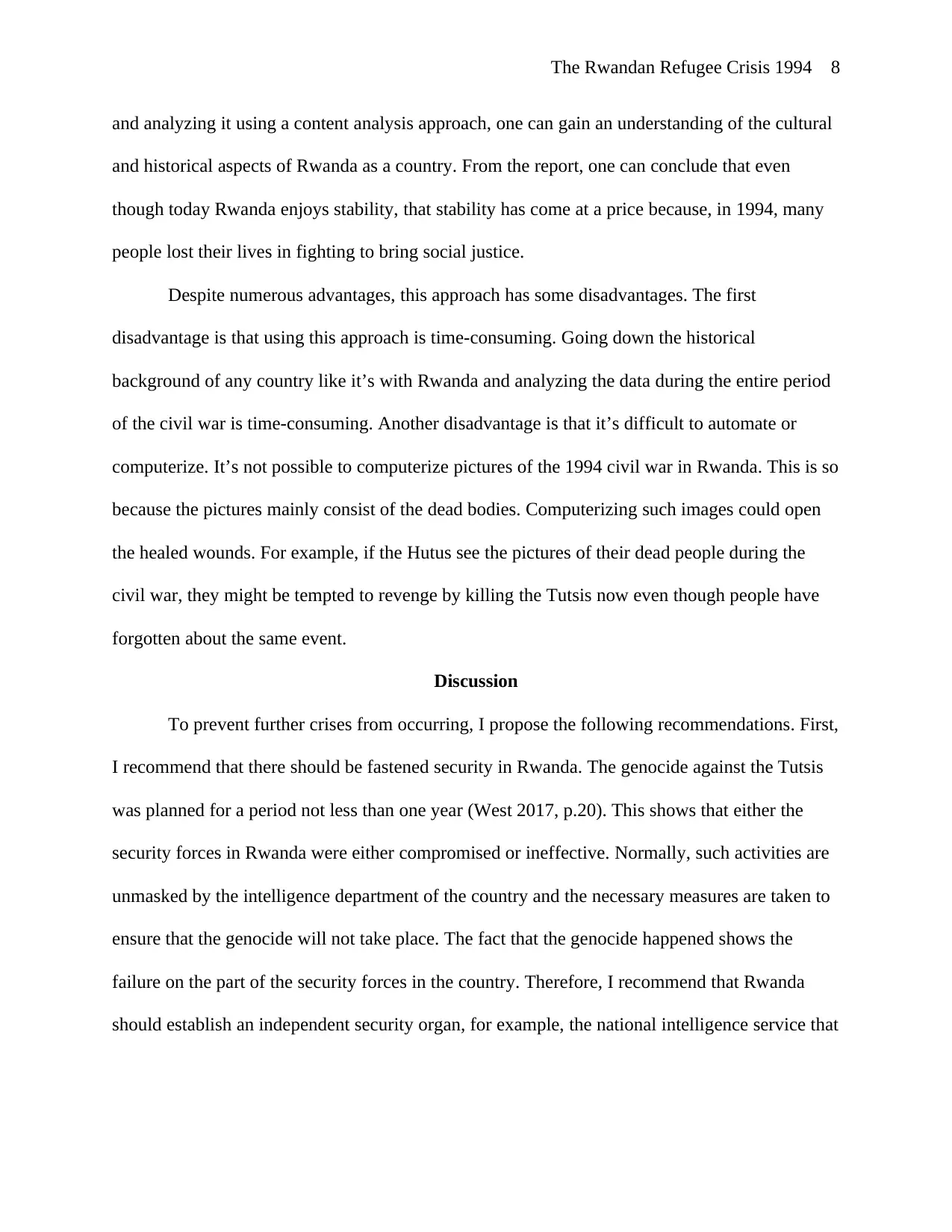
The Rwandan Refugee Crisis 1994 8
and analyzing it using a content analysis approach, one can gain an understanding of the cultural
and historical aspects of Rwanda as a country. From the report, one can conclude that even
though today Rwanda enjoys stability, that stability has come at a price because, in 1994, many
people lost their lives in fighting to bring social justice.
Despite numerous advantages, this approach has some disadvantages. The first
disadvantage is that using this approach is time-consuming. Going down the historical
background of any country like it’s with Rwanda and analyzing the data during the entire period
of the civil war is time-consuming. Another disadvantage is that it’s difficult to automate or
computerize. It’s not possible to computerize pictures of the 1994 civil war in Rwanda. This is so
because the pictures mainly consist of the dead bodies. Computerizing such images could open
the healed wounds. For example, if the Hutus see the pictures of their dead people during the
civil war, they might be tempted to revenge by killing the Tutsis now even though people have
forgotten about the same event.
Discussion
To prevent further crises from occurring, I propose the following recommendations. First,
I recommend that there should be fastened security in Rwanda. The genocide against the Tutsis
was planned for a period not less than one year (West 2017, p.20). This shows that either the
security forces in Rwanda were either compromised or ineffective. Normally, such activities are
unmasked by the intelligence department of the country and the necessary measures are taken to
ensure that the genocide will not take place. The fact that the genocide happened shows the
failure on the part of the security forces in the country. Therefore, I recommend that Rwanda
should establish an independent security organ, for example, the national intelligence service that
and analyzing it using a content analysis approach, one can gain an understanding of the cultural
and historical aspects of Rwanda as a country. From the report, one can conclude that even
though today Rwanda enjoys stability, that stability has come at a price because, in 1994, many
people lost their lives in fighting to bring social justice.
Despite numerous advantages, this approach has some disadvantages. The first
disadvantage is that using this approach is time-consuming. Going down the historical
background of any country like it’s with Rwanda and analyzing the data during the entire period
of the civil war is time-consuming. Another disadvantage is that it’s difficult to automate or
computerize. It’s not possible to computerize pictures of the 1994 civil war in Rwanda. This is so
because the pictures mainly consist of the dead bodies. Computerizing such images could open
the healed wounds. For example, if the Hutus see the pictures of their dead people during the
civil war, they might be tempted to revenge by killing the Tutsis now even though people have
forgotten about the same event.
Discussion
To prevent further crises from occurring, I propose the following recommendations. First,
I recommend that there should be fastened security in Rwanda. The genocide against the Tutsis
was planned for a period not less than one year (West 2017, p.20). This shows that either the
security forces in Rwanda were either compromised or ineffective. Normally, such activities are
unmasked by the intelligence department of the country and the necessary measures are taken to
ensure that the genocide will not take place. The fact that the genocide happened shows the
failure on the part of the security forces in the country. Therefore, I recommend that Rwanda
should establish an independent security organ, for example, the national intelligence service that
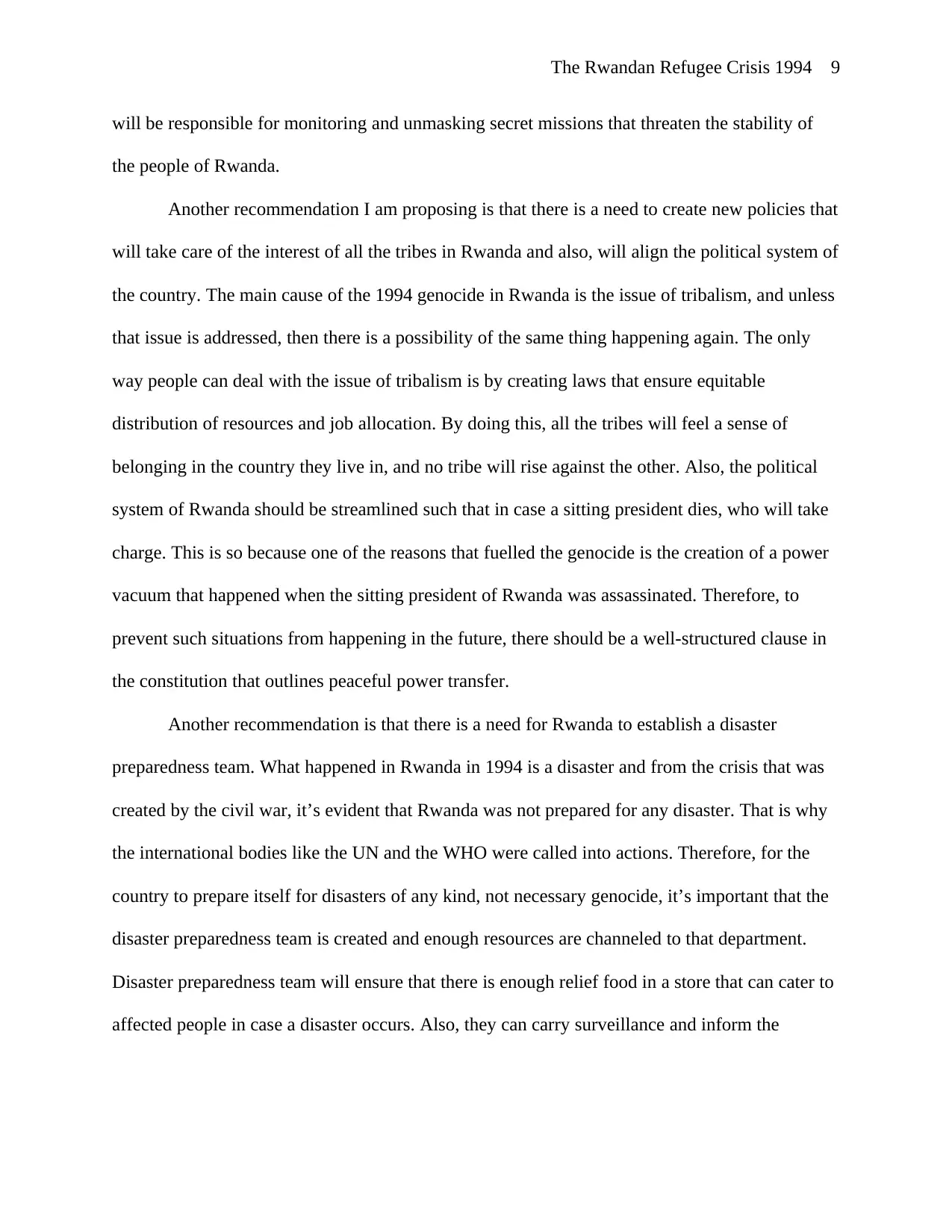
The Rwandan Refugee Crisis 1994 9
will be responsible for monitoring and unmasking secret missions that threaten the stability of
the people of Rwanda.
Another recommendation I am proposing is that there is a need to create new policies that
will take care of the interest of all the tribes in Rwanda and also, will align the political system of
the country. The main cause of the 1994 genocide in Rwanda is the issue of tribalism, and unless
that issue is addressed, then there is a possibility of the same thing happening again. The only
way people can deal with the issue of tribalism is by creating laws that ensure equitable
distribution of resources and job allocation. By doing this, all the tribes will feel a sense of
belonging in the country they live in, and no tribe will rise against the other. Also, the political
system of Rwanda should be streamlined such that in case a sitting president dies, who will take
charge. This is so because one of the reasons that fuelled the genocide is the creation of a power
vacuum that happened when the sitting president of Rwanda was assassinated. Therefore, to
prevent such situations from happening in the future, there should be a well-structured clause in
the constitution that outlines peaceful power transfer.
Another recommendation is that there is a need for Rwanda to establish a disaster
preparedness team. What happened in Rwanda in 1994 is a disaster and from the crisis that was
created by the civil war, it’s evident that Rwanda was not prepared for any disaster. That is why
the international bodies like the UN and the WHO were called into actions. Therefore, for the
country to prepare itself for disasters of any kind, not necessary genocide, it’s important that the
disaster preparedness team is created and enough resources are channeled to that department.
Disaster preparedness team will ensure that there is enough relief food in a store that can cater to
affected people in case a disaster occurs. Also, they can carry surveillance and inform the
will be responsible for monitoring and unmasking secret missions that threaten the stability of
the people of Rwanda.
Another recommendation I am proposing is that there is a need to create new policies that
will take care of the interest of all the tribes in Rwanda and also, will align the political system of
the country. The main cause of the 1994 genocide in Rwanda is the issue of tribalism, and unless
that issue is addressed, then there is a possibility of the same thing happening again. The only
way people can deal with the issue of tribalism is by creating laws that ensure equitable
distribution of resources and job allocation. By doing this, all the tribes will feel a sense of
belonging in the country they live in, and no tribe will rise against the other. Also, the political
system of Rwanda should be streamlined such that in case a sitting president dies, who will take
charge. This is so because one of the reasons that fuelled the genocide is the creation of a power
vacuum that happened when the sitting president of Rwanda was assassinated. Therefore, to
prevent such situations from happening in the future, there should be a well-structured clause in
the constitution that outlines peaceful power transfer.
Another recommendation is that there is a need for Rwanda to establish a disaster
preparedness team. What happened in Rwanda in 1994 is a disaster and from the crisis that was
created by the civil war, it’s evident that Rwanda was not prepared for any disaster. That is why
the international bodies like the UN and the WHO were called into actions. Therefore, for the
country to prepare itself for disasters of any kind, not necessary genocide, it’s important that the
disaster preparedness team is created and enough resources are channeled to that department.
Disaster preparedness team will ensure that there is enough relief food in a store that can cater to
affected people in case a disaster occurs. Also, they can carry surveillance and inform the

The Rwandan Refugee Crisis 1994 10
government in advance of the impending disaster in advance. This will help the government
prepare in advance about the disaster.
When implementing the above solutions, I recommend that it’s important for the
Rwandan government to consider the following international strategies. First, it’s the Global
strategy. The global strategy refers to a strategic guide to globalization. Globalization means that
the world operates as one community that is connected in all aspects. Based on this strategy, it
means that whatever affects Rwanda will also directly or indirectly affect other countries.
Therefore, it’s important for Rwanda to implement the proposed solutions with considerations of
the interest of other countries. For example, when implementing the solution to insecurity in the
country, it’s important to consider the security of the foreigners who live in Rwanda. This will
mean that there should be a proper way for foreigners to come and leave the country otherwise;
they should be considered illegal immigrants. This will ensure that Rwanda maintains co-
existence with her neighbors as detected by the global strategy. Another international strategy
that should be considered is the multi-domestic strategy. Multi-domestic strategy detects that
there should be measures taken to ensure maximum local responsiveness by the businesses and
other relevant body within the country. The government while implementing these solutions
should do that knowing that it’s fully responsible for all the locals in the country. For example,
while implementing the solution to security, no innocent citizen should suffer because only the
criminals should be targeted. Also, when creating a disaster management team, the government
should ensure that those affected by the disasters are given priority by this team. In addition to
this, the policies created should be supported by good will from the government. By doing this,
the government will be showing how responsible it’s to the citizens of the country.
government in advance of the impending disaster in advance. This will help the government
prepare in advance about the disaster.
When implementing the above solutions, I recommend that it’s important for the
Rwandan government to consider the following international strategies. First, it’s the Global
strategy. The global strategy refers to a strategic guide to globalization. Globalization means that
the world operates as one community that is connected in all aspects. Based on this strategy, it
means that whatever affects Rwanda will also directly or indirectly affect other countries.
Therefore, it’s important for Rwanda to implement the proposed solutions with considerations of
the interest of other countries. For example, when implementing the solution to insecurity in the
country, it’s important to consider the security of the foreigners who live in Rwanda. This will
mean that there should be a proper way for foreigners to come and leave the country otherwise;
they should be considered illegal immigrants. This will ensure that Rwanda maintains co-
existence with her neighbors as detected by the global strategy. Another international strategy
that should be considered is the multi-domestic strategy. Multi-domestic strategy detects that
there should be measures taken to ensure maximum local responsiveness by the businesses and
other relevant body within the country. The government while implementing these solutions
should do that knowing that it’s fully responsible for all the locals in the country. For example,
while implementing the solution to security, no innocent citizen should suffer because only the
criminals should be targeted. Also, when creating a disaster management team, the government
should ensure that those affected by the disasters are given priority by this team. In addition to
this, the policies created should be supported by good will from the government. By doing this,
the government will be showing how responsible it’s to the citizens of the country.
Secure Best Marks with AI Grader
Need help grading? Try our AI Grader for instant feedback on your assignments.
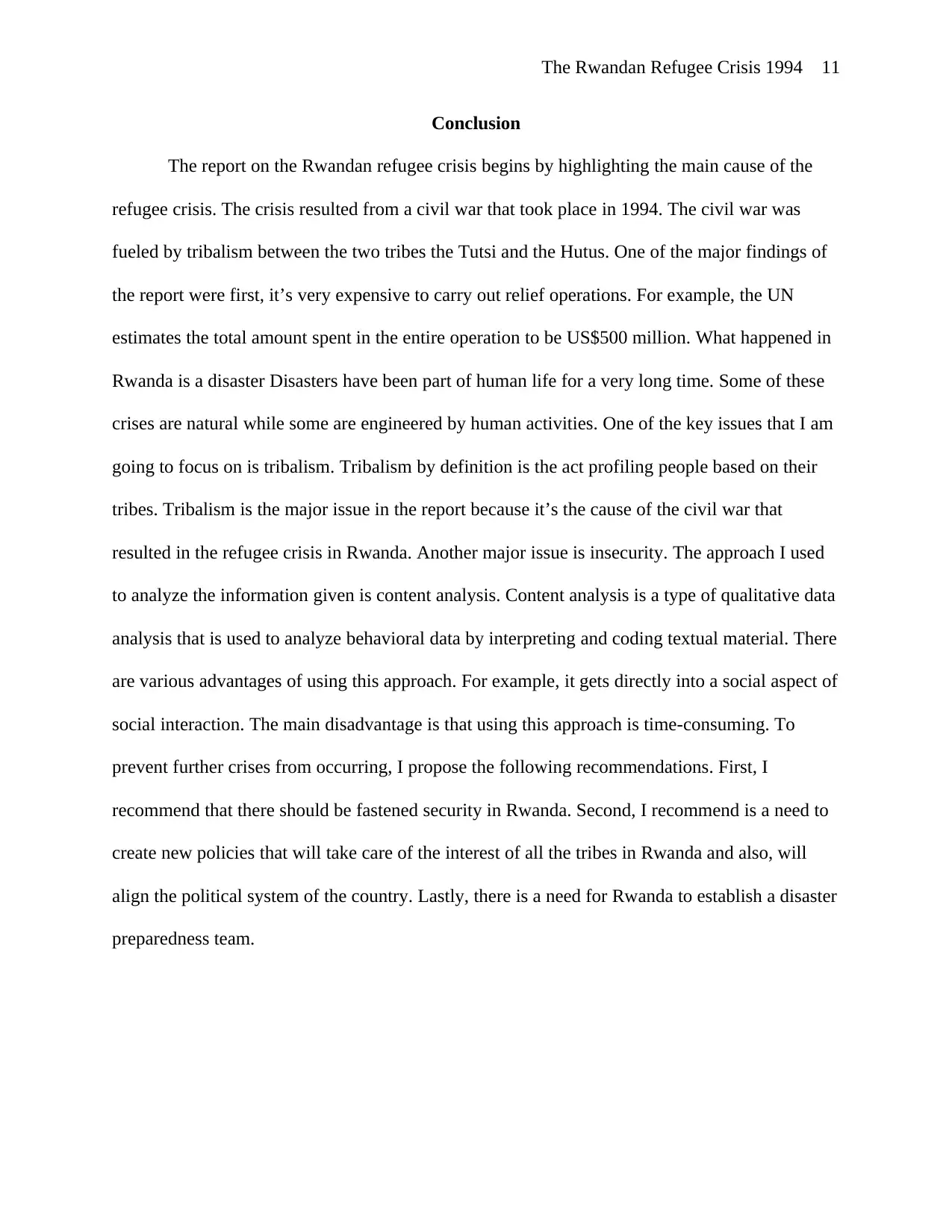
The Rwandan Refugee Crisis 1994 11
Conclusion
The report on the Rwandan refugee crisis begins by highlighting the main cause of the
refugee crisis. The crisis resulted from a civil war that took place in 1994. The civil war was
fueled by tribalism between the two tribes the Tutsi and the Hutus. One of the major findings of
the report were first, it’s very expensive to carry out relief operations. For example, the UN
estimates the total amount spent in the entire operation to be US$500 million. What happened in
Rwanda is a disaster Disasters have been part of human life for a very long time. Some of these
crises are natural while some are engineered by human activities. One of the key issues that I am
going to focus on is tribalism. Tribalism by definition is the act profiling people based on their
tribes. Tribalism is the major issue in the report because it’s the cause of the civil war that
resulted in the refugee crisis in Rwanda. Another major issue is insecurity. The approach I used
to analyze the information given is content analysis. Content analysis is a type of qualitative data
analysis that is used to analyze behavioral data by interpreting and coding textual material. There
are various advantages of using this approach. For example, it gets directly into a social aspect of
social interaction. The main disadvantage is that using this approach is time-consuming. To
prevent further crises from occurring, I propose the following recommendations. First, I
recommend that there should be fastened security in Rwanda. Second, I recommend is a need to
create new policies that will take care of the interest of all the tribes in Rwanda and also, will
align the political system of the country. Lastly, there is a need for Rwanda to establish a disaster
preparedness team.
Conclusion
The report on the Rwandan refugee crisis begins by highlighting the main cause of the
refugee crisis. The crisis resulted from a civil war that took place in 1994. The civil war was
fueled by tribalism between the two tribes the Tutsi and the Hutus. One of the major findings of
the report were first, it’s very expensive to carry out relief operations. For example, the UN
estimates the total amount spent in the entire operation to be US$500 million. What happened in
Rwanda is a disaster Disasters have been part of human life for a very long time. Some of these
crises are natural while some are engineered by human activities. One of the key issues that I am
going to focus on is tribalism. Tribalism by definition is the act profiling people based on their
tribes. Tribalism is the major issue in the report because it’s the cause of the civil war that
resulted in the refugee crisis in Rwanda. Another major issue is insecurity. The approach I used
to analyze the information given is content analysis. Content analysis is a type of qualitative data
analysis that is used to analyze behavioral data by interpreting and coding textual material. There
are various advantages of using this approach. For example, it gets directly into a social aspect of
social interaction. The main disadvantage is that using this approach is time-consuming. To
prevent further crises from occurring, I propose the following recommendations. First, I
recommend that there should be fastened security in Rwanda. Second, I recommend is a need to
create new policies that will take care of the interest of all the tribes in Rwanda and also, will
align the political system of the country. Lastly, there is a need for Rwanda to establish a disaster
preparedness team.

The Rwandan Refugee Crisis 1994 12
References
Baines, E.K., 2017. Vulnerable bodies: Gender, the UN and the global refugee crisis. Routledge.
Beswick, D., 2014. The risks of African military capacity building: Lessons from
Rwanda. African Affairs, 113(451), pp.212-231.
Bariagaber, A., 2016. Conflict and the refugee experience: flight, exile, and repatriation in the
Horn of Africa. Routledge.
Dubernet, C., 2017. The international containment of displaced persons: humanitarian spaces
without exit. Routledge.
Evans, G. (2014). Responding to crises in the African Great Lakes. Routledge.
Halvorsen, K., 2017. Protection and humanitarian assistance in the refugee camps in Zaire: The
problem of security. In The Path of a Genocide (pp. 307-320). Routledge.
Rutinwa, B. 2017. The end of asylum? The changing nature of refugee policies in Africa.
In International Refugee Law (pp. 35-64). Routledge.
Waters, T. 2018. Bureaucratizing the Good Samaritan: The limitations of humanitarian relief
operations. Routledge.
West, K., 2017. Agents of Altruism: The Expansion of Humanitarian NGOs in Rwanda and
Afghanistan: The Expansion of Humanitarian NGOs in Rwanda and Afghanistan. Routledge.
Yamashita, H., 2017. Humanitarian space and international politics: the creation of safe areas.
Routledge.
References
Baines, E.K., 2017. Vulnerable bodies: Gender, the UN and the global refugee crisis. Routledge.
Beswick, D., 2014. The risks of African military capacity building: Lessons from
Rwanda. African Affairs, 113(451), pp.212-231.
Bariagaber, A., 2016. Conflict and the refugee experience: flight, exile, and repatriation in the
Horn of Africa. Routledge.
Dubernet, C., 2017. The international containment of displaced persons: humanitarian spaces
without exit. Routledge.
Evans, G. (2014). Responding to crises in the African Great Lakes. Routledge.
Halvorsen, K., 2017. Protection and humanitarian assistance in the refugee camps in Zaire: The
problem of security. In The Path of a Genocide (pp. 307-320). Routledge.
Rutinwa, B. 2017. The end of asylum? The changing nature of refugee policies in Africa.
In International Refugee Law (pp. 35-64). Routledge.
Waters, T. 2018. Bureaucratizing the Good Samaritan: The limitations of humanitarian relief
operations. Routledge.
West, K., 2017. Agents of Altruism: The Expansion of Humanitarian NGOs in Rwanda and
Afghanistan: The Expansion of Humanitarian NGOs in Rwanda and Afghanistan. Routledge.
Yamashita, H., 2017. Humanitarian space and international politics: the creation of safe areas.
Routledge.
1 out of 12
Your All-in-One AI-Powered Toolkit for Academic Success.
+13062052269
info@desklib.com
Available 24*7 on WhatsApp / Email
![[object Object]](/_next/static/media/star-bottom.7253800d.svg)
Unlock your academic potential
© 2024 | Zucol Services PVT LTD | All rights reserved.